Acquisitions Administration
Acquisitions Settings
Several setting in the Library Settings area of the Administration module pertain to functions in the Acquisitions module. You can access these settings by clicking Administration → Local Administration → Library Settings Editor.
-
CAT: Delete bib if all copies are deleted via Acquisitions lineitem cancellation - If you cancel a line item, then all of the on order copies in the catalog are deleted. If, when you cancel a line item, you also want to delete the bib record, then set this setting to TRUE.
-
Allow funds to be rolled over without bringing the money along - enables you to move a fund’s encumbrances from one year to the next without moving unspent money. Unused money is not added to the next year’s fund and is not available for use.
-
Allows patrons to create automatic holds from purchase requests.
-
Default circulation modifier - This modifier would be applied to items that are created in the acquisitions module
-
Default copy location - This copy location would be applied to items that are created in the acquisitions module
-
Fund Spending Limit for Block - When the amount remaining in the fund, including spent money and encumbrances, goes below this percentage, attempts to spend from the fund will be blocked.
-
Fund Spending Limit for Warning - When the amount remaining in the fund, including spent money and encumbrances, goes below this percentage, attempts to spend from the fund will result in a warning to the staff.
-
Rollover Distribution Formulae Funds - When set to true, during fiscal rollover, all distribution formulae will update to use new funds.
-
Set copy creator as receiver - When receiving a copy in acquisitions, set the copy "creator" to be the staff that received the copy
-
Temporary barcode prefix - Temporary barcode prefix for items that are created in the acquisitions module
-
Temporary call number prefix - Temporary call number prefix for items that are created in the acquisitions module
Cancel/Delay reasons
The Cancel reasons link enables you to predefine the reasons for which a line item or a PO can be cancelled. A default list of reasons appears, but you can add custom reasons to this list. Applying the cancel reason will prevent the item from appearing in a claims list and will allow you to cancel debits associated with the purchase. Cancel reasons also enable you to delay a purchase. For example, you could create a cancel reason of 'back ordered,' and you could choose to keep the debits associated with the purchase.
Create a cancel/delay reason
-
To add a new cancel reason, click Administration → Acquisitions Administration → Cancel reasons.
-
Click New Cancel Reason.
-
Select a using library from the drop-down menu. The using library indicates the organizational units whose staff can use this cancel reason. This menu is populated with the shortnames that you created for your libraries in the organizational units tree (See Administration → Server Administration → Organizational Units.)
-
Create a label for the cancel reason. This label will appear when you select a cancel reason on an item or a PO.
-
Create a description of the cancel reason. This is a free text field and can comprise any text of your choosing.
-
If you want to retain the debits associated with the cancelled purchase, click the box adjacent to Keep Debits→
-
Click Save.
Delete a custom cancel/delay reason
You can delete custom cancel reason.
-
Select the checkbox for the custom cancel reason that should be deleted.
-
Click the Delete Selected button.
| You cannot select the checkbox for any of the default cancel reasons because the system expects those reasons to be available to handle EDI order responses. |
Claiming
Currently, all claiming is manual, but the admin module enables you to build claim policies and specify the action(s) that users should take to claim items.
Create a claim policy
The claim policy link enables you to name the claim policy and specify the organization that owns it.
-
To create a claim policy, click Administration → Acquisitions Administration → Claim Policies.
-
Create a claim policy name. No limits exist on the number of characters that can be entered in this field.
-
Select an org unit from the drop-down menu. The org unit indicates the organizational units whose staff can use this claim policy. This menu is populated with the shortnames that you created for your libraries in the organizational units tree (See Administration → Server Administration → Organizational Units).
The rule of parental inheritance applies to this list. -
Enter a description. No limits exist on the number of characters that can be entered in this field.
-
Click Save.
Create a claim type
The claim type link enables you to specify the reason for a type of claim.
-
To create a claim type, click Administration → Acquisitions Administration → Claim types.
-
Create a claim type. No limits exist on the number of characters that can be entered in this field.
-
Select an org unit from the drop-down menu. The org unit indicates the organizational units whose staff can use this claim type. This menu is populated with the shortnames that you created for your libraries in the organizational units tree (See Administration → Server Administration → Organizational Units).
The rule of parental inheritance applies to this list. -
Enter a description. No limits exist on the number of characters that can be entered in this field.
-
Click Save.
Create a claim event type
The claim event type describes the physical action that should occur when an item needs to be claimed. For example, the user should notify the vendor via email that the library is claiming an item.
-
To access the claim event types, click Administration → Acquisitions Administration → Claim event type.
-
Enter a code for the claim event type. No limits exist on the number of characters that can be entered in this field.
-
Select an org unit from the drop-down menu. The org unit indicates the organizational units whose staff can use this event type. This menu is populated with the shortnames that you created for your libraries in the organizational units tree (See Administration → Server Administration → Organizational Units).
The rule of parental inheritance applies to this list. -
Enter a description. No limits exist on the number of characters that can be entered in this field.
-
If this claim is initiated by the user, then check the box adjacent to Library Initiated.
Currently, all claims are initiated by a user. The ILS cannot automatically claim an issue. -
Click Save.
Create a claim policy action
The claim policy action enables you to specify how long a user should wait before claiming the item.
-
To access claim policy actions, click Administration → Acquisitions Administration → Claim Policy Actions.
-
Select an Action (Event Type) from the drop-down menu.
-
Enter an action interval. This field indicates how long a user should wait before claiming the item.
-
In the Claim Policy ID field, select a claim policy from the drop-down menu.
-
Click Save.
| You can create claim cycles by adding multiple claim policy actions to a claim policy. |
Currency Types
Currency types can be created and applied to funds in the administrative module. When a fund is applied to a copy or line item for purchase, the item will be purchased in the currency associated with that fund.
Create a currency type
-
To create a new currency type, click Administration → Acquisitions Administration → Currency types.
-
Enter the currency code. No limits exist on the number of characters that can be entered in this field.
-
Enter the name of the currency type in Currency Label field. No limits exist on the number of characters that can be entered in this field.
-
Click Save.
Edit a currency type
-
To edit a currency type, click your cursor in the row that you want to edit. The row will turn blue.
-
Double click. The pop-up box will appear, and you can edit the fields.
-
After making changes, click Save.
| From the currency types interface, you can delete currencies that have never been applied to funds or used to make purchases. |
Distribution Formulas
Distribution formulas allow you to specify the number of copies that should be distributed to specific branches. They can also serve as templates allowing you to predefine settings for your copies. You can create and reuse formulas as needed.
Create a distribution formula
-
Click Administration → Acquisitions Administration → Distribution Formulas.
-
Click New Formula.
-
Enter a Formula Name. No limits exist on the number of characters that can be entered in this field.
-
Choose a Formula Owner from the drop-down menu. The Formula Owner indicates the organizational units whose staff can use this formula. This menu is populated with the shortnames that you created for your libraries in the organizational units tree (See Administration → Server Administration → Organizational Units).
The rule of parental inheritance applies to this list. -
Ignore the Skip Count field which is currently not used.
-
Click Save.
-
Click New Entry.
-
Select an Owning Library from the drop-down menu. This indicates the branch that will receive the items. This menu is populated with the shortnames that you created for your libraries in the organizational units tree (See Administration → Server Administration → Organizational Units).
-
Select/enter any of the following copy details you want to predefine in the distribution formula.
-
Copy Location
-
Fund
-
Circ Modifier
-
Collection Code
-
-
In the Item Count field, enter the number of items that should be distributed to the branch. You can enter the number or use the arrows on the right side of the field.
-
Click Apply Changes. The screen will reload.
-
To view the changes to your formula, click Administration → Acquisitions Administration → Distribution Formulas. The item_count will reflect the entries to your distribution formula.
| To edit the Formula Name, click the hyperlinked name of the formula in the top left corner. A pop-up box will enable you to enter a new formula name. |
Electronic Data Interchange
Many libraries use Electronic Data Interchange (EDI) accounts to send purchase orders and receive invoices from providers electronically. In Evergreen users can setup EDI accounts and manage EDI messages in the admin module. EDI messages and notes can be viewed in the acquisitions module. See also the command line system administration manual, which includes some initial setup steps that are required for use of EDI.
Entering SANs (Standard Address Numbers)
For EDI to work your library must have a SAN and each of your providers must each supply you with their SAN.
A SAN (Standard Address Number) is a unique 7 digit number that identifies your library.
Entering a Library’s SAN
These steps only need to be done once per library.
-
In Evergreen select Administration → Server Administration → Organizational Units
-
Find your library in the tree on the left side of the page and click on it to open the settings.
Multi-branch library systems will see an entry for each branch but should select their system’s top organization unit. -
Click on the Address tab.
-
Click on the Mailing Address tab.
-
Enter your library’s SAN in the field labeled SAN.
-
Click Save.
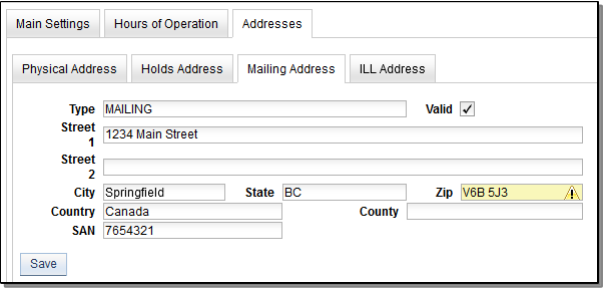
Entering a Provider’s SAN
These steps need to be repeated for every provider with which EDI is used.
-
In Evergreen select Administration → Acquisitions Administration → Providers.
-
Click the hyperlinked name of the provider you would like to edit.
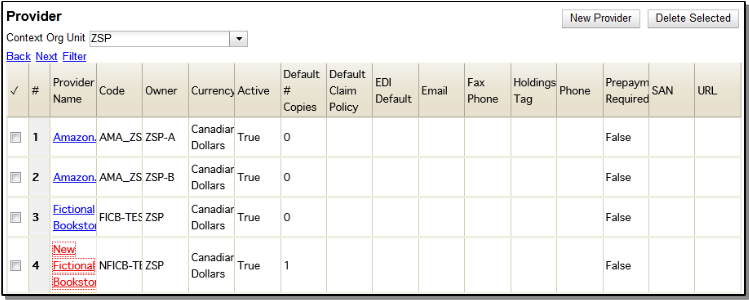
-
Enter your provider’s SAN in the field labeled SAN.
-
Click Save.

Create an EDI Account
| You must create your provider before you create an EDI account for the provider. |
-
Contact your provider requesting the following information:
-
Host
-
Username
-
Password
-
Path
-
Incoming Directory
-
Provider’s SAN
-
-
In Evergreen select Administration → Acquisitions Administration → EDI Accounts.
-
Click New Account. A pop-up will appear.
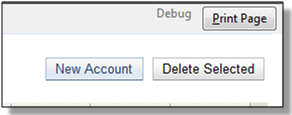
-
Fill in the following fields:
-
In the Label field, enter a name for the EDI account.
-
In the Host field, enter the requisite FTP or SCP information supplied by your provider. Be sure to include the protocol (e.g.
ftp://ftp.vendorname.com) -
In the Username field, enter the username supplied by your provider.
-
In the Password field, enter the password supplied by your provider.
-
Select your library as the Owner from the drop down menu. Multi-branch libraries should select their top level organizational unit.
-
The Last Activity updates automatically with any inbound or outbound communication.
-
In the Provider field, enter the code used in Evergreen for your provider.
-
In the Path field, enter the path supplied by your provider. The path indicates a directory on the provider’s server where Evergreen will deposit its outgoing order files.
If your vendor requests a specific file extension for EDI purchase orders, such as .ord, enter the name of the directory, followed by a slash, followed by an asterisk, followed by a period, followed by the extension. For example, if the vendor requests that EDI purchase orders be sent to a directory calledinwith the file extension.ord, your path would bein/*.ord. -
In the Incoming Directory field, enter the incoming directory supplied by your provider. This indicates the directory on the vendor’s server where Evergreen will retrieve incoming order responses and invoices.
Don’t worry if your incoming directory is named outoroutgoing. From your vendor’s perspective, this directory is outgoing, because it contains files that the vendor is sending to Evergreen. However, from Evergreen’s perspective, these files are incoming.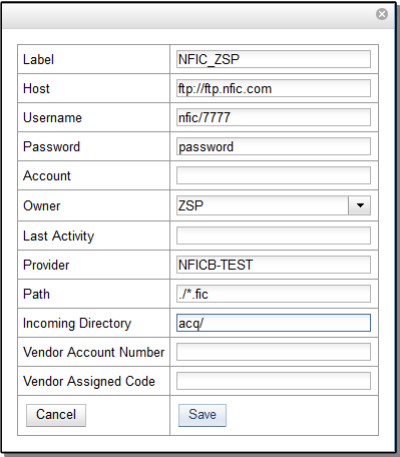
-
-
Click Save.
-
Click on the link in the Provider field.

-
Select the EDI account that has just been created from the EDI Default drop down menu.
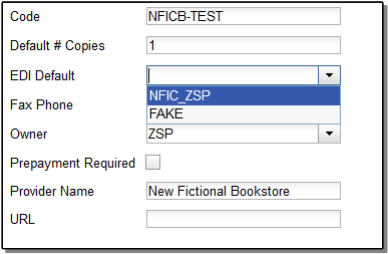
-
Click Save.
EDI Messages
The EDI Messages screen displays all incoming and outgoing messages between the library and its providers. To see details of a particular EDI message, including the raw EDIFACT message, double click on a message entry. To find a specific EDI message, the Filter options can be useful. Outside the Admin interface, EDI messages that pertain to a specific purchase order can be viewed from the purchase order interface (See Acquisitions → Purchase Orders).
Exchange Rates
Exchange rates define the rate of exchange between currencies. Evergreen will automatically calculate exchange rates for purchases. Evergreen assumes that the currency of the purchasing fund is identical to the currency of the provider, but it provides for two unique situations: If the currency of the fund that is used for the purchase is different from the currency of the provider as listed in the provider profile, then Evergreen will use the exchange rate to calculate the price of the item in the currency of the fund and debit the fund accordingly. When money is transferred between funds that use different currency types, Evergreen will automatically use the exchange rate to convert the money to the currency of the receiving fund. During such transfers, however, staff can override the automatic conversion by providing an explicit amount to credit to the receiving fund.
Create an exchange rate
-
To create a new exchange rate, click Administration → Acquisitions Administration → Exchange Rates.
-
Click New Exchange Rate.
-
Enter the From Currency from the drop-down menu populated by the currency types.
-
Enter the To Currency from the drop-down menu populated by the currency types.
-
Enter the exchange Ratio.
-
Click Save.
MARC Federated Search
The MARC Federated Search enables you to import bibliographic records into a selection list or purchase order from a Z39.50 source.
-
Click Acquisitions → MARC Federated Search.
-
Check the boxes of Z39.50 services that you want to search. Your local Evergreen Catalog is checked by default. Click Submit.
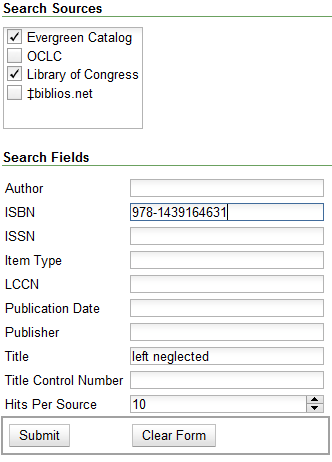
-
A list of results will appear. Click the Copies link to add copy information to the line item. See Line Item Features for more information.
-
Click the Notes link to add notes or line item alerts to the line item. See Line Item Features for more information.
-
Enter a price in the Estimated Price field.
-
You can save the line item(s) to a selection list by checking the box on the line item and clicking Actions → Save Items to Selection List. You can also create a purchase order from the line item(s) by checking the box on the line item and clicking Actions → Create Purchase Order.

Fund Tags
You can apply tags to funds so that you can group funds for easy reporting. For example, you have three funds for children’s materials: Children’s Board Books, Children’s DVDs, and Children’s CDs. Assign a fund tag of 'children’s' to each fund. When you need to report on the amount that has been spent on all children’s materials, you can run a report on the fund tag to find total expenditures on children’s materials rather than reporting on each individual fund.
Create a Fund Tag
-
To create a fund tag, click Administration → Acquisitions Administration → Fund Tags.
-
Click New Fund Tag. No limits exist on the number of characters that can be entered in this field.
-
Select a Fund Tag Owner from the drop-down menu. The owner indicates the organizational unit(s) whose staff can use this fund tag. This menu is populated with the shortnames that you created for your libraries in the organizational units tree (See Administration → Server Administration → Organizational Units).
The rule of parental inheritance applies to this list. -
Enter a Fund Tag Name. No limits exist on the number of characters that can be entered in this field.
-
Click Save.
Funding Sources
Funding sources allow you to specify the sources that contribute monies to your fund(s). You can create as few or as many funding sources as you need. These can be used to track exact amounts for accounts in your general ledger. You can then use funds to track spending and purchases for specific collections.
Create a funding source
-
To create a new funding source, click Administration → Acquisitions Administration → Funding Source.
-
Enter a funding source name. No limits exist on the number of characters that can be entered in this field.
-
Select an owner from the drop-down menu. The owner indicates the organizational unit(s) whose staff can use this funding source. This menu is populated with the shortnames that you created for your libraries in the organizational units tree (See Administration → Server Administration → Organizational Units).
The rule of parental inheritance applies to this list. For example, if a system is made the owner of a funding source, then users with appropriate permissions at the branches within the system could also use the funding source. -
Create a code for the source. No limits exist on the number of characters that can be entered in this field.
-
Select a currency from the drop-down menu. This menu is populated from the choices in the Currency Types interface.
-
Click Save.
Allocate credits to funding sources
-
Apply a credit to this funding source.
-
Enter the amount of money that the funding source contributes to the organization. Funding sources are not tied to fiscal or calendar years, so you can continue to add money to the same funding source over multiple years, e.g. County Funding. Alternatively, you can name funding sources by year, e.g. County Funding 2010 and County Funding 2011, and apply credits each year to the matching source.
-
To apply a credit, click on the hyperlinked name of the funding source. The Funding Source Details will appear.
-
Click Apply Credit.
-
Enter an amount to apply to this funding source.
-
Enter a note. This field is optional.
-
Click Apply.
Allocate credits to funds
If you have already set up your funds, then you can then click the Allocate to Fund button to apply credits from the funding sources to the funds. If you have not yet set up your funds, or you need to add a new one, you can allocate credits to funds from the funds interface. See section 1.2 for more information.
-
To allocate credits to funds, click Allocate to Fund.
-
Enter the amount that you want to allocate.
-
Enter a note. This field is optional.
-
Click Apply.
Funds
Funds allow you to allocate credits toward specific purchases. In the funds interface, you can create funds; allocate credits from funding sources to funds; transfer money between funds; and apply fund tags to funds. Funds are created for a specific year, either fiscal or calendar. These funds are owned by org units. At the top of the funds interface, you can set a contextual org unit and year. The drop-down menu at the top of the screen enables you to focus on funds that are owned by specific organizational units during specific years.
Create a fund
-
To create a new fund, click Administration → Acquisitions Administration → Funds.
-
Enter a name for the fund. No limits exist on the number of characters that can be entered in this field.
-
Create a code for the fund. No limits exist on the number of characters that can be entered in this field.
-
Enter a year for the fund. This can be a fiscal year or a calendar year. The format of the year is YYYY.
-
Select an org unit from the drop-down menu. The org unit indicates the organizational units whose staff can use this fund. This menu is populated with the shortnames that you created for your libraries in the organizational units tree (See Administration → Server Administration → Organizational Units).
The rule of parental inheritance applies to this list. See section -
Select a currency type from the drop-down menu. This menu is comprised of entries in the currency types menu. When a fund is applied to a line item or copy, the price of the item will be encumbered in the currency associated with the fund.
-
Click the Active box to activate this fund. You cannot make purchases from this fund if it is not active.
-
Enter a Balance Stop Percent. The balance stop percent prevents you from making purchases when only a specified amount of the fund remains. For example, if you want to spend 95 percent of your funds, leaving a five percent balance in the fund, then you would enter 95 in the field. When the fund reaches its balance stop percent, it will appear in red when you apply funds to copies.
-
Enter a Balance Warning Percent. The balance warning percent gives you a warning that the fund is low. You can specify any percent. For example, if you want to spend 90 percent of your funds and be warned when the fund has only 10 percent of its balance remaining, then enter 90 in the field. When the fund reaches its balance warning percent, it will appear in yellow when you apply funds to copies.
-
Check the Propagate box to propagate funds. When you propagate a fund, the ILS will create a new fund for the following fiscal year with the same parameters as your current fund. All of the settings transfer except for the year and the amount of money in the fund. Propagation occurs during the fiscal year close-out operation.
-
Check the Rollover box if you want to roll over remaining funds into the same fund next year. You should also check this box if you only want to roll over encumbrances into next year’s fund.
-
Click Save.
Allocate credits from funding sources to funds
Credits can be applied to funds from funding sources using the fund interface. The credits that you apply to the fund can be applied later to purchases.
-
To access funds, click Administration → Acquisitions Administration → Funds.
-
Click the hyperlinked name of the fund.
-
To add a credit to the fund, click the Create Allocation tab.
-
Choose a Funding Source from the drop-down menu.
-
Enter an amount that you want to apply to the fund from the funding source.
-
Enter a note. This field is optional.
-
Click Apply.
Transfer credits between funds
The credits that you allocate to funds can be transferred between funds if desired. In the following example, you can transfer $500.00 from the Young Adult Fiction fund to the Children’s DVD fund.
-
To access funds, click Administration → Acquisitions Administration → Funds.
-
Click the hyperlinked name of the originating fund.
-
The Fund Details screen appears. Click Transfer Money.
-
Enter the amount that you would like to transfer.
-
From the drop-down menu, select the destination fund.
-
Add a note. This field is optional.
-
Click Transfer.
Track balances and expenditures
The Fund Details allows you to track the fund’s balance, encumbrances, and amount spent. It also allows you to track allocations from the funding source(s), debits, and fund tags.
-
To access the fund details, click on the hyperlinked name of the fund that you created.
-
The Summary allows you to track the following:
-
Balance - The balance is calculated by subtracting both items that have been invoiced and encumbrances from the total allocated to the fund.
-
Total Allocated - This amount is the total amount allocated from the Funding Source.
-
Spent Balance - This balance is calculated by subtracting only the items that have been invoiced from the total allocated to the fund. It does not include encumbrances.
-
Total Debits - The total debits are calculated by adding the cost of items that have been invoiced and encumbrances.
-
Total Spent - The total spent is calculated by adding the cost of items that have been invoiced. It does not include encumbrances.
-
Total Encumbered - The total encumbered is calculated by adding all encumbrances.
Fund reporting
A core source, Fund Summary, is available in the reports interface. This core source enables librarians to easily run a report on fund activity. Fields that are accessible in this interface include Remaining Balance, Total Allocated, Total Encumbered, and Total Spent.

Perform fiscal year close-out operation
The Fiscal Year Close-Out Operation allows you to deactivate funds for the current year and create analogous funds for the next year. It transfers encumbrances to the analogous funds, and it rolls over any remaining funds if you checked the rollover box when creating the fund.
-
To access the year end closeout of a fund, click Administration → Server Administration → Acquisitions → Funds.
-
Click Fund Propagation and Rollover.
-
Check the box adjacent to Perform Fiscal Year Close-Out Operation.
-
For funds that have the "Rollover" setting enabled, if you want to move the fund’s encumbrances to the next year without moving unspent money, check the box adjacent to Limit Fiscal Year Close-out Operation to Encumbrances.
The Limit Fiscal Year Close-out Operation to Encumbrances will only display if the Allow funds to be rolled over without bringing the money along Library Setting has been enabled. This setting is available in the Library Setting Editor accessible via Administration → Local Administration → Library Settings Editor. 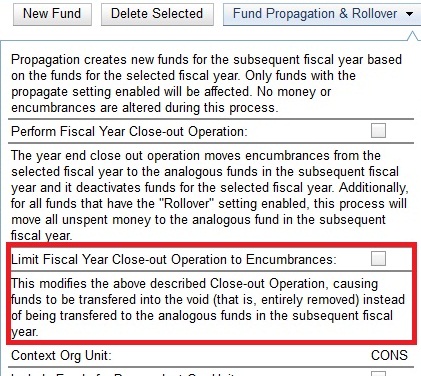
-
Notice that the context org unit reflects the context org unit that you selected at the top of the Funds screen.
-
If you want to perform the close-out operation on the context org unit and its child units, then check the box adjacent to Include Funds for Descendant Org Units.
-
Check the box adjacent to dry run if you want to test changes to the funds before they are enacted. Evergreen will generate a summary of the changes that would occur during the selected operations. No data will be changed.
-
Click Process.
-
Evergreen will begin the propagation process. Evergreen will make a clone of each fund, but it will increment the year by 1.
Invoice menus
Invoice menus allow you to create drop-down menus that appear on invoices. You can create an invoice item type or invoice payment method.
Invoice item type
The invoice item type allows you to enter the types of additional charges that you can add to an invoice. Examples of additional charge types might include taxes or processing fees. Charges for bibliographic items are listed separately from these additional charges. A default list of charge types displays, but you can add custom charge types to this list. Invoice item types can also be used when adding non-bibliographic items to a purchase order. When invoiced, the invoice item type will copy from the purchase order to the invoice.
-
To create a new charge type, click Administration → Acquisitions Administration → Invoice Item Type.
-
Click New Invoice Item Type.
-
Create a code for the charge type. No limits exist on the number of characters that can be entered in this field.
-
Create a label. No limits exist on the number of characters that can be entered in this field. The text in this field appears in the drop-down menu on the invoice.
-
If items on the invoice were purchased with the monies in multiple funds, then you can divide the additional charge across funds. Check the box adjacent to Prorate→ if you want to prorate the charge across funds.
-
Click Save.
Invoice payment method
The invoice payment method allows you to predefine the type(s) of invoices and payment method(s) that you accept. The text that you enter in the admin module will appear as a drop-down menu in the invoice type and payment method fields on the invoice.
-
To create a new invoice payment method, click Administration → Acquisitions Administration → Invoice Payment Method.
-
Click New Invoice Payment Method.
-
Create a code for the invoice payment method. No limits exist on the number of characters that can be entered in this field.
-
Create a name for the invoice payment method. No limits exist on the number of characters that can be entered in this field. The text in this field appears in the drop-down menu on the invoice.
-
Click Save.
Payment methods can be deleted from this screen.
Line Item Features
Line item alerts are predefined text that can be added to line items that are on selection lists or purchase orders. You can define the alerts from which staff can choose. Line item alerts appear in a pop-up box when the line item, or any of its copies, are marked as received.
Create a line item alert
-
To create a line item alert, click Administration → Acquisitions Administration → Line Item Alerts.
-
Click New Line Item Alert Text.
-
Create a code for the text. No limits exist on the number of characters that can be entered in this field.
-
Create a description for the text. No limits exist on the number of characters that can be entered in this field.
-
Select an owning library from the drop-down menu. The owning library indicates the organizational units whose staff can use this alert. This menu is populated with the shortnames that you created for your libraries in the organizational units tree (See Administration → Server Administration → Organizational Units).
-
Click Save.
Line item MARC attribute definitions
Line item attributes define the fields that Evergreen needs to extract from the bibliographic records that are in the acquisitions database to display in the catalog. Also, these attributes will appear as fields in the New Brief Record interface. You will be able to enter information for the brief record in the fields where attributes have been defined.
Providers
Providers are vendors. You can create a provider profile that includes contact information for the provider, holdings information, invoices, and other information.
Create a provider
-
To create a new provider, click Administration → Acquisitions Administration → Providers.
-
Enter the provider name.
-
Create a code for the provider. No limits exist on the number of characters that can be entered in this field.
-
Select an owner from the drop-down menu. The owner indicates the organizational units whose staff can use this provider. This menu is populated with the shortnames that you created for your libraries in the organizational units tree (See Administration → Server Administration → Organizational Units).
The rule of parental inheritance applies to this list. -
Select a currency from the drop-down menu. This drop-down list is populated by the list of currencies available in the currency types.
-
A provider must be active in order for purchases to be made from that provider. To activate the provider, check the box adjacent to Active. To deactivate a vendor, uncheck the box.
-
Add the default # of copies that are typically ordered through the provider. This number will automatically populate the line item’s Copies box on any PO’s associated with this provider. If another quantity is entered during the selection or ordering process, it will override this default. If no number is specified, the default number of copies will be zero.
-
Select a default claim policy from the drop-down box. This list is derived from the claim policies that can be created
-
Select an EDI default. This list is derived from the EDI accounts that can be created.
-
Enter the provider’s email address.
-
In the Fax Phone field, enter the provider’s fax number.
-
In the holdings tag field, enter the tag in which the provider places holdings data.
-
In the phone field, enter the provider’s phone number.
-
If prepayment is required to purchase from this provider, then check the box adjacent to prepayment required.
-
Enter the Standard Address Number (SAN) for your provider.
-
Enter the web address for the provider’s website in the URL field.
-
Click Save.
Add contact and holdings information to providers
After you save the provider profile, the screen reloads so that you can save additional information about the provider. You can also access this screen by clicking the hyperlinked name of the provider on the Providers screen. The tabs allow you to add a provider address and contact, attribute definitions, and holding subfields. You can also view invoices associated with the provider.
-
Enter a Provider Address, and click Save.
Required fields for the provider address are: Street 1, city, state, country, post code. You may have multiple valid addresses. -
Enter the Provider Contact, and click Save.
-
Your vendor may include information that is specific to your organization in MARC tags. You can specify the types of information that should be entered in each MARC tag. Enter attribute definitions to correlate MARC tags with the information that they should contain in incoming vendor records. Some technical knowledge is required to enter XPath information. As an example, if you need to import the PO Name, you could set up an attribute definition by adding an XPath similar to:
code => purchase_order xpath => //*[@tag="962"]/*[@code="p"] Is Identifier => false
where 962 is the holdings tag and p is the subfield that contains the PO Name.
-
You may have entered a holdings tag when you created the provider profile. You can also enter holdings subfields. Holdings subfields allow you to specify subfields within the holdings tag to which your vendor adds holdings information, such as quantity ordered, fund, and estimated price.
-
Click invoices to access invoices associated with a provider.